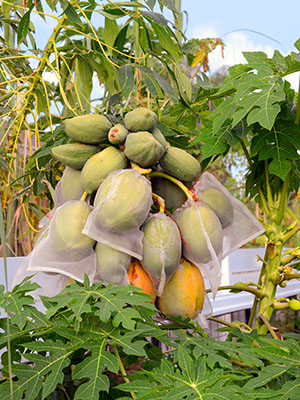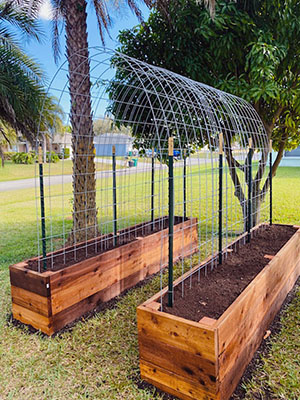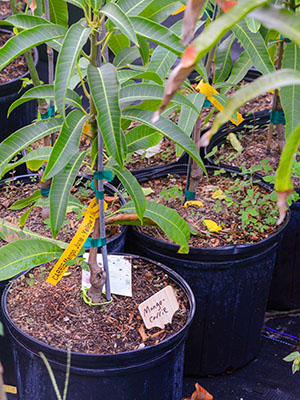Producing produce
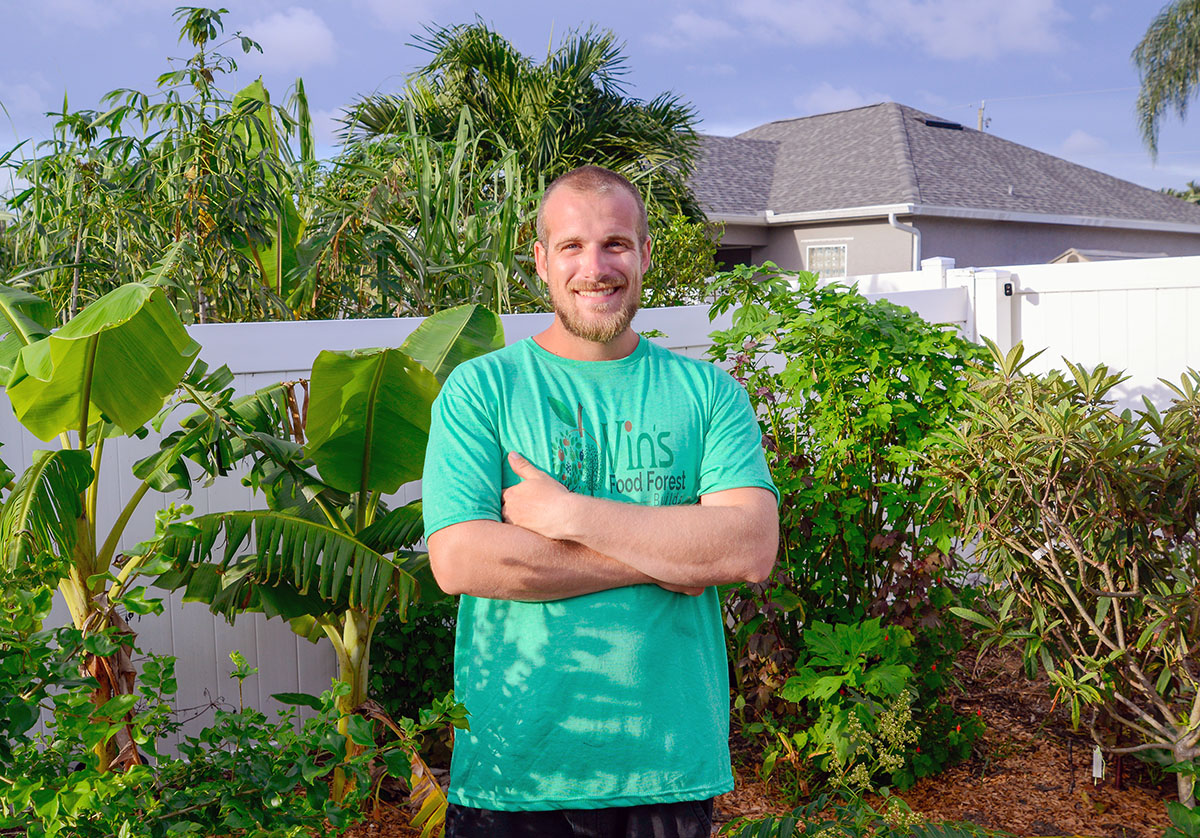
Backyard garden grows into new lifestyle and prosperous business
BY RACHEL INSWASTY

"As humans living in the modern world, we have lost valuable knowledge of growing practices,” Vincent Bellezza, owner and operator of Vin’s Food Forest Builds, says, “But once you get it, you get it.”
Bellezza moved to the Fort Lauderdale area from Pennsylvania in 2011. After moving to Port St. Lucie in 2017, he and his growing family began to explore gardening in their backyard in 2019. Bellezza and his wife, Amanda, were becoming more aware of the many extra ingredients added into seemingly regular grocery-store food products.
With this new knowledge, they felt empowered to pivot toward a lifestyle that included eating more whole foods and growing their own fruits and vegetables. His goal was to replace as much of the store-bought food as possible with their home-grown produce.
“At some point I was starting to realize that the food on the shelves was full of artificial garbage,” Bellezza says, “I have a 7-, 5- and 2-year-old so I was becoming more aware of what we were eating and buying from the grocery store.”
Before this new lifestyle shift, Bellezza was a licensed insurance agent until 2015 but stayed in the industry as part of the sales leads business. After buying his home and planting several tropical fruit plants, he shifted his work toward creating gardens and growing more plants.
Bellezza started intensively researching information on gardening and food forests. A food forest can be best described as a garden with edible plants that mimics the natural ecosystem of a forest. Everything in a forest has created its own system in order to remain self-sustaining. In turn, Bellezza aims to create mostly self-sustaining food forests and landscapes for his clients.
“For many people, the less work they have to put in, the better,” Bellezza says. “But I also provide education on good growing practice for all of my clients.”
NOT A NEW CONCEPT
While food forests seem to be a new concept, the practice has been used for many years across the globe. To better understand just how valuable food forests can be, forest biomes are home to upward of 80 percent of the Earth’s animals and plants. Trees take in carbon dioxide and produce oxygen while also serving as homes for millions of helpful insects and microorganisms.
“I started with planting some tropical fruit trees, specifically papaya,” Bellezza says. “I got fruit from those pretty quickly and that was really exciting.”
Bellezza says he started exploring this new realm by planting many different types of tropical fruit trees in his free time. Among the many trees he planted were papaya, mango, Jamaican cherry, mulberry, cacao, avocado and starfruit.
“It was really fun and very exciting to see how quickly the papaya plant bore fruit for us,” Bellezza says. “At that point I was more drawn to experimenting with growing many varieties of fruits and veggies as well as grafting.
“As children, my little sister and I ate fruits from the trees during recess at school,” Bellezza says, “They were so delicious and we later found out they were loquats. The loquat tree was the first I ever grafted.”
Bellezza says that grafting sounds scarier and more intimidating than it actually is. He watched videos, read books and experimented heavily in order to perfect the process. He has two grafted loquat trees in his yard that produce several varieties on each tree.
“My next-door neighbor noticed how many papayas I had and I gladly gifted him some,” Bellezza says, “Not too long after, they started giving me sugar cane stalks as soon as they were sweet and ready.”
SPREADING THE SEEDS AROUND
Bellezza began to post to a local gardening Facebook group offering to give away extra plants or searching for trades. His neighbors noticed the many seedlings he was growing and Bellezza started to trade or gift them.
The many seedlings Bellezza was growing turned into mature, fruiting plants. With so many trees on property, Bellezza says he had what he described as a nursery.
In the beginning of 2021, Bellezza was meeting with neighbors Bill and Bev Smith to give them some plants. After finding out he was still in the insurance business, Bellezza was invited over to assist them in choosing new policies. After a lot of conversation, Bev Smith asked if Bellezza would be willing to help with some yard work given his plant knowledge. The idea of turning this hobby into a career launched Bellezza into the direction to start his business.
“That job turned into many fun months of transforming the yard of their newly acquired home,” Bellezza says. “It made me realize what my passions were and led to the creation of Vin’s Food Forest Builds.”
At the end of 2021, Bellezza filed the necessary paperwork to open his company. At the same time, he had his nursery, which has upward of 50 different fruit plants and trees, certified through the Florida Department of Agriculture.
“One of the first things I ask clients is, ‘What do you buy most at the store and is the food for snacking or food security?’ ” Bellezza says. “We also explore whether they want something more low maintenance or if the client is going to be in the garden every day to maintain.”
IT’S ALL ABOUT THE SOIL
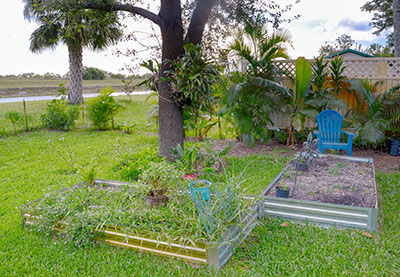
Bellezza explains that it is important to prepare and aerate the soil before planting to get microbes activated. Soil microbes include fungi, bacteria, viruses, archaea and protozoa. Bellezza stresses the importance of keeping the soil covered with mulch for protection and to help microorganisms thrive. Mulch breaks down over time and provides the soil with the necessary nutrients it needs in order to help plants thrive.
“Soil is everything and compost adds life,” Bellezza says. “If you are experiencing issues with disease and fungus or have plants being attacked by bugs often, it usually has to do with soil health.”
While earthworms and millipedes are an excellent sign of healthy soil, Bellezza says that grubs are not favorable because they eat away at root systems. Worms aerate the soil and leave behind castings that are full of plant nutrients. Bellezza suggests starting with a tumbler for composting. Add in fruits and veggie scraps, egg shells, coffee grounds and leaves, grass cuttings or mulch. He says to avoid adding citrus, onions and meat to compost bins.
“Food forests work so well because the more plants you have, the more beneficial bugs there are to control one another,” he says. “They all work together to sustain the food forest.”
Presently, the nursery has June plum, Barbados cherry, sugar-apple, starfruit, yellow and red strawberry trees, papaya, Cecropia [nature’s gummy worm] and loquat trees that are fruiting. He says that cranberry hibiscus is in full bloom and makes an excellent pink tea.
Bellezza is passionate about creating edible landscapes and food forests and hopes more people will utilize the yard space they have. His goal is to save enough money to get a larger piece of land to build a food forest and grow more trees.
“Neighbors, clients, family and friends have been really supportive, and I think we are all learning from one another,” Bellezza says. “It has definitely created an awesome sense of community and now we get to trade food, not just plants.”
See the original article in the print publication
Jan. 9, 2023

